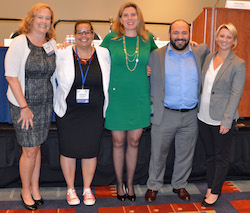I had the opportunity to facilitate a lively discussion on effective stakeholder messaging during the BioEnergy 2105 conference. “Reaching Your Stakeholders: Effectively Engaging and Educating Key Audiences,” discussed success stories, best practices and lessons learned that have helped to improve public perception of bioenergy at all levels. The panel featured: Melissa Savage, Senior Program Director with the National Association of State Energy Officials; Aaron Wells, Communications Consultant for Fuels America; Wendy Rosen, Leader, Global Public Affairs for DuPont Industrial Biosciences; and Emily York, Vice President of Communications for Abengoa.

BioEnergy 2015 communication panaelists. From left to right: Melissa Savage, Senior Program Director with the National Association of State Energy Officials; Joanna Schroeder, Editor, DomesticFuel.com;Wendy Rosen, Leader, Global Public Affairs for DuPont Industrial Biosciences; Aaron Wells, Communications Consultant for Fuels America; and Emily York, Vice President of Communications for Abengoa.
The discussion kicked off with acknowledging that perception is reality and the industry needs to change its perception a bit. One way to do this is to tell the story the right way. Oftentimes, however, public relations professionals don’t provide enough information for journalists to make a valid assessment of the story. Rather, a company needs to package all they want to say. The hook is critical because this will entice a reporter to want to tell the story or a person seeking information what to hear the story. Once you have a journalist hooked, tell the story through the lens of one person, an engineer or farmer, for example. Include visuals – photography, videos and infographics. Also, be mindful of using too much jargon – this is a story killer.
As a journalist, I appreciate the advice of the panelists in telling the story. I receive dozens of press releases each day and some are so horribly written that I delete them even though I know there is probably a good story hidden somewhere in the jargon. On days there is too much news, the stories I focus on have not only a good story but also visuals to accompany that story (and no, a logo is not the visual us reporters are looking for). Another good piece of advice, pitching a few strategic stories is better than flooding the market. If you send me an email or release every day, I’m going to start ignoring you and ultimately miss a great story.
Some other helpful advice from the panelists:
Aaron Wells: “Antis” get the industry riled up and focused on playing defense. Remember that the best defense is good offense. Also, he noted that its important to educate the audience you are going to need down the road so when a negative story comes out, this is not the first time the reporter has heard from you, but, be selective in when to respond.
Melissa Savage – Deliver short, concise impactful stories. Her organization has a page of 1-liners they use when working with legislative audiences.
Wendy Rosen – The game has changed so the ways and places people are being influenced are different and when a person feels she is being marketed to, she tunes out. So be transparent about what you’re doing. Be credible.
Emily York – Don’t assume you know what the message is. Do your due diligence of researching your audience so you get them what they need when they start looking.
Ultimately, being able to tell not only a good story and modify the story for your audience but a great story is going to make or break the success of your communications.

